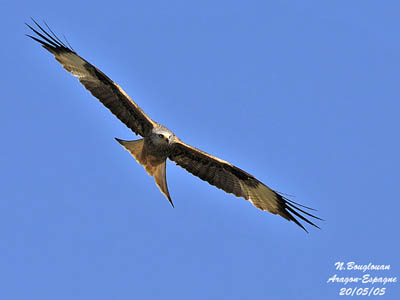
Text by Nicole Bouglouan
Photographers :
Buysse Didier
Vision d’Oiseaux
Patrick Ingremeau
TAMANDUA
Nicole Bouglouan
PHOTOGRAPHIC RAMBLE
Sources :
HANDBOOK OF THE BIRDS OF THE WORLD Vol 2 by Josep del Hoyo-Andrew Elliot-Jordi Sargatal - Lynx Edicions - ISBN: 8487334156
L’ENCYCLOPEDIE MONDIALE DES OISEAUX - Dr Christopher M. Perrins - BORDAS - ISBN: 2040185607
GUIDE DES RAPACES DIURNES – Europe, Afrique du Nord et Moyen-Orient de Benny Génsbol – Delachaux et Niestlé – ISBN : 2603013270
ENCYCLOPEDIE DES OISEAUX DE FRANCE ET D’EUROPE – de Peter Hayman et Rob Hume - Flammarion – ISBN : 2082009920
Cuckoo-hawks, Kites, Honey-buzzards
Third subgroup
2 - Old World Kites
The four species of Old World Kites are gathered in two genera. The genus Milvus includes the Red Kite (Milvus milvus) and the Black Kite (Milvus migrans). The other genus, Haliastur, also includes two species, the Whistling Kite (Haliastur sphenurus) and the Brahminy Kite (Haliastur Indus).
Both members of genus Milvus are slightly larger than the others.
Black Kite and Red Kite could have similar appearance, but some details make the difference between them. The Red Kite has redder plumage and more forked tail with reddish base. The underwing show larger, whiter patches on the primaries. The head is whitish with dark streaks. The bill is yellow with dark tip and yellowish cere. Eyes are pale yellow. Legs and feet are yellow.

Milvus milvus
The Black Kite is browner with slightly forked tail. The underwing patches are greyer and less distinct. The head is brownish-grey with fine dark streaks. The bill is black with yellow cere. The eyes are yellowish. Legs and feet are yellow.
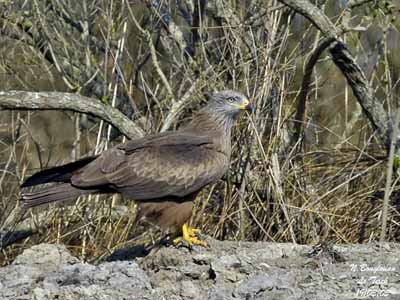
Milvus migrans
They frequent wooded areas for nesting and roosting, and usually avoid dense forests. The Red Kite favours the open areas, wood mixed with pasture or farmland, whereas the Black Kite is often found in more aquatic habitats along wetlands, rivers and lakes and even seashores. Both are associated to human and frequent urban areas and rubbish-dumps when available.
They are fairly gregarious and roost communally in trees.
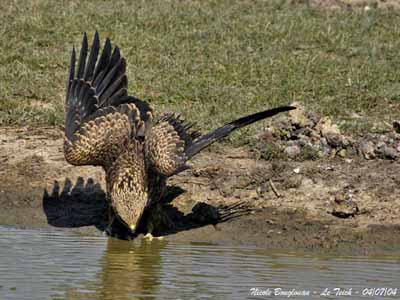
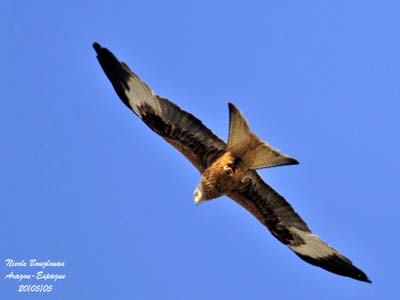
Black Kite - Milvus migrans
Red Kite - Milvus milvus
They feed on wide range of food types such as carrion and animal remains from abattoirs or fisheries, road kills, scraps… They also hunt and catch small preys such as rodents and birds, and insects. The Black Kite takes more fish and crustaceans from its aquatic habitats, but the fish is usually dead or disabled, found on the margins of water bodies.
The Red Kite forages in open areas by soaring and diving onto the prey.
Both take insects on the wing or from the ground.
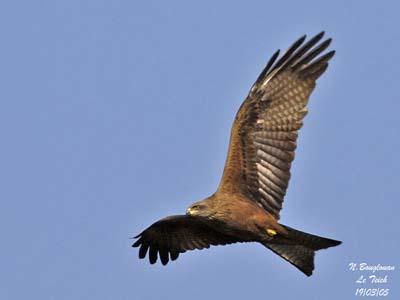
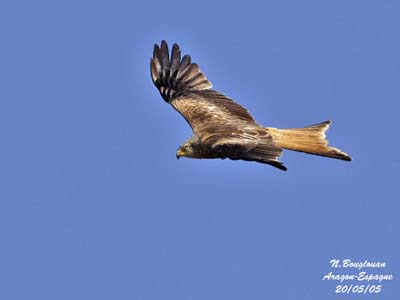
They nest in trees. They build a stick nest, often lined with plastic, paper or dung. The Black Kite may also nest on cliff ledges according to the location. They perform acrobatic flight displays, typical of raptors, above the nest-site or the territory.
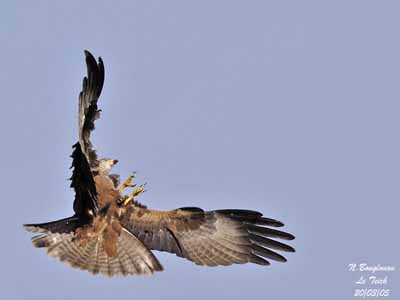
Milvus migrans
Two or three eggs are laid, and the incubation lasts between 26 and 38 days, mainly by the female fed by the male during this period. The chicks are fed by the female but the male brings the food. The young fledge between 45 and 60 days, but they are still fed by the adults for some weeks more.
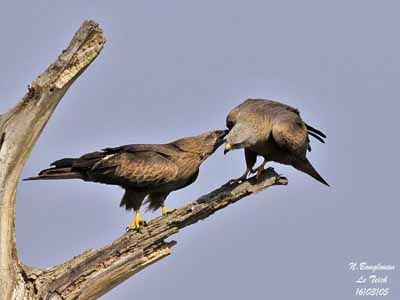
Both species are migratory, but the Red Kite tends to become more sedentary. Populations from N and C Europe can migrate, but those of the southern parts and some other regions only disperse after the breeding season.
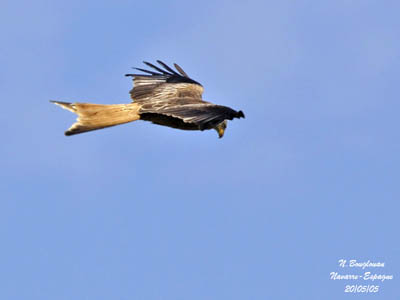
Milvus milvus
However, the Black Kite migrates. It breeds in Europe and winters in sub-Saharan Africa, India, south-east Asia and N Australia.
They migrate in flocks and gather to cross the straits.
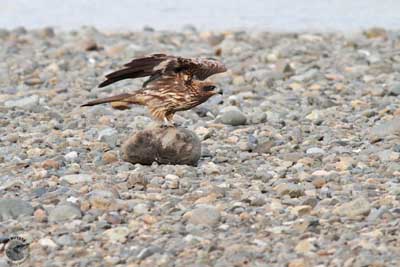
Black-eared Kite
Milvus migrans lineatus
Subspecies of the Black Kite
Both species are still threatened by persecutions and poisoning, hunting, and are affected by the removal of small rubbish dumps. Poisoning by pesticides and chemical pollution of water also play an important role in declines. They are considered as Near Threatened.
The Whistling Kite (Haliastur sphenurus) and the Brahminy Kite (Haliastur Indus) belong to the genus Haliastur.
The first one has pale reddish-brown plumage overall, with pale edged feathers on the upperwing and dark-streaked underparts with whitish lower belly and vent. The bill is blackish with grey cere. Eyes are brown. Legs and feet are pale greyish. It has longer tail and primary flight feathers than the Brahminy Kite which has different plumage with dark reddish-brown upperparts, lower belly and vent. The head, upper mantle, chin, throat, breast and upper belly are white, finely streaked grey. The primary flight feathers are blackish. The bill is pale yellowish with yellow cere. Eyes are dark brown. Legs and feet are yellow.
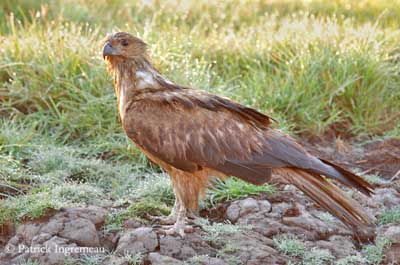
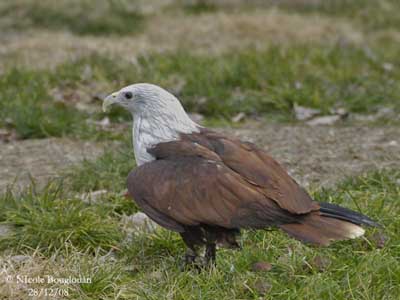
The Whistling Kite frequents open habitat with some trees near inland and marine wetlands. The Brahminy Kite is found in estuaries, coasts, terrestrial wetlands and urban areas. According to the range, it may occur over forest, cultivated areas and grassland far from water, mainly in tropics.
They feed on numerous small animals and carrion, from mammals, birds and reptiles to amphibians, fish and crustaceans, and can be attracted by large carcasses and offal.
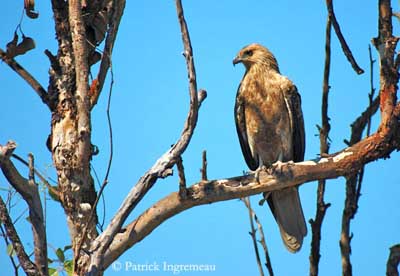
Whistling Kite
Haliastur sphenurus
They forage by high soaring and dive onto the prey or perform short chases, and the Brahminy Kite can also hunt from exposed perch. It also searches on the ground. They hawks flying insects and snatch preys from water surface.
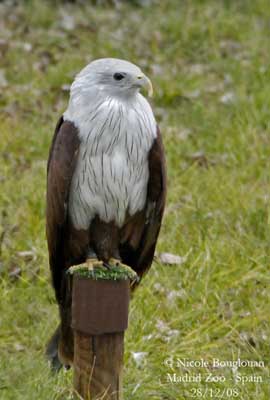
They nest solitary, but the Whistling Kite can also breed near other raptors’ species. They build a platform with sticks lined with softer materials and green leaves. The nest is placed in tree or sometimes in artificial structure.
Usually two eggs are laid, and the female incubates during about 35-38 days. The young fledge between 45 and 55 days, but they still depend on parents for some weeks more.
The Whistling Kite is partially migratory and dispersive within Australia. The populations from S and SE often winter in northern areas. Some birds can be resident in temperate and tropical regions.
The Brahminy Kite is mainly resident in Australia and Asia, only performing local movements according to the food sources. The breeding pairs are sedentary.
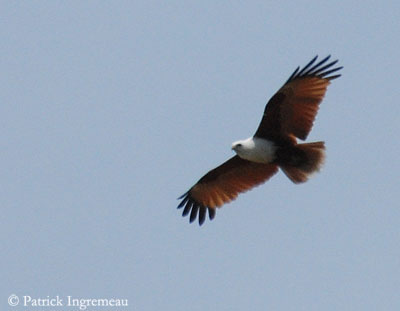
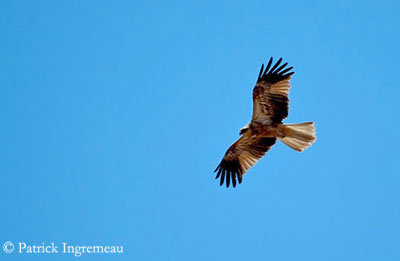
Both species are common or abundant in their ranges and have benefited from human activities. However, the drainage of wetlands in S Australia involves some lack of food from the Whistling Kite.
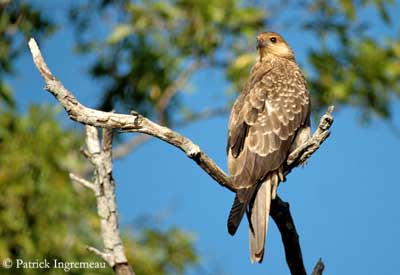
Whistling Kite
Haliastur sphenurus
The Brahminy Kite suffered declines throughout Java and inland regions in Thailand due to pesticides, hunting pressure, trade with the chicks and loss of breeding habitat.